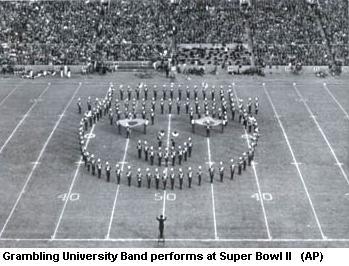In-Game Entertainment: The "Other" Main Event
By: Jason Arcuri
One of the best ways to examine and trace the transformation of the Super Bowl into an entertainment spectacle would be to look at the development of the "non-game", those segments of the television broadcast which are seen when the game is not on. Though the game itself has always remained a 60-minute affair, the inclusion of the pre-game show, half-time report, half-time show and post-game coverage into the broadcast has effectively turned the Super Bowl into a 12 hour TV marathon. However, it is interesting to note that this phenomenon is fairly recent, and is in stark contrast to the early Super Bowl broadcasts in which "non-game" elements were considered to be relatively insignificant (Rader, 1984, p.97).
Making it harder to dispel the theory of television influence, one should consider how this emphasis of both the Super Bowl's entertainment orientation and its "non-game" coincidentally coincided with the emergence of televisuality in the late-1970s and early-1980s. Seen as a direct response to the changing social conditions and character of the time (which celebrated wealth, capitalism and over-consumption), this new TV format began to focus on "excessive style" (Caldwell, 2000, p.649) rather than the basic program content. For many, this was eerily similar to the new direction in which the Super Bowl ideology was headed; moving away from content (the game itself) and focusing more on style (the entertainment value).
Of all the "non-game"
segments, this trend towards style over substance can best be viewed
through the Super Bowl's half-time show, which has become as recognized
as the game itself. Specifically, by looking back at the history
of the performances which have taken place over the years, it
is obvious that there has been a definite progression
towards something which resembles a modern day pop / rock  concert.
In its early incarnations, the half-time show mainly featured college
marching bands who took up most of the 20-minute (its regular length)
intermission performing only for the in-stadium audience. Since
the television broadcast focused on game analysis, the majority
of these performances were not televised (Rader,
1984, p.100). During the '70s and '80s, it was clear that the
half-time show had picked up on the trend of televisuality. Though
it slightly extended the normal length of half-time, the show became
much more of an actual production which was aimed towards both the
stadium and the television audience. As well, it is to this that
we owe the creation of the "Up With People" performers.
concert.
In its early incarnations, the half-time show mainly featured college
marching bands who took up most of the 20-minute (its regular length)
intermission performing only for the in-stadium audience. Since
the television broadcast focused on game analysis, the majority
of these performances were not televised (Rader,
1984, p.100). During the '70s and '80s, it was clear that the
half-time show had picked up on the trend of televisuality. Though
it slightly extended the normal length of half-time, the show became
much more of an actual production which was aimed towards both the
stadium and the television audience. As well, it is to this that
we owe the creation of the "Up With People" performers.

|
Disclaimer © 2003 - 2004 by class of SOSC 4319 at York University |